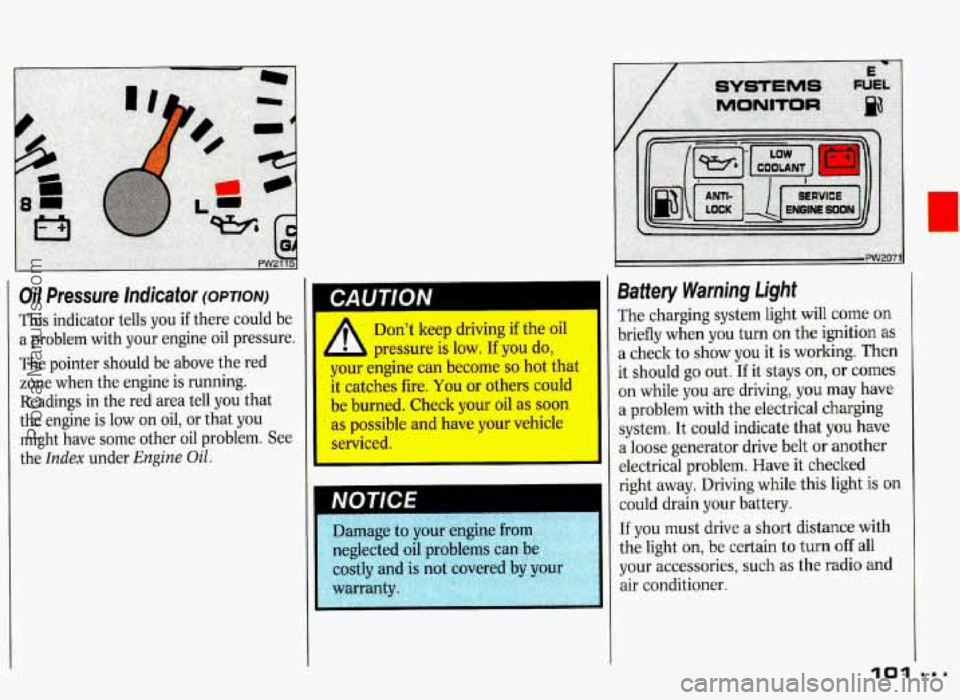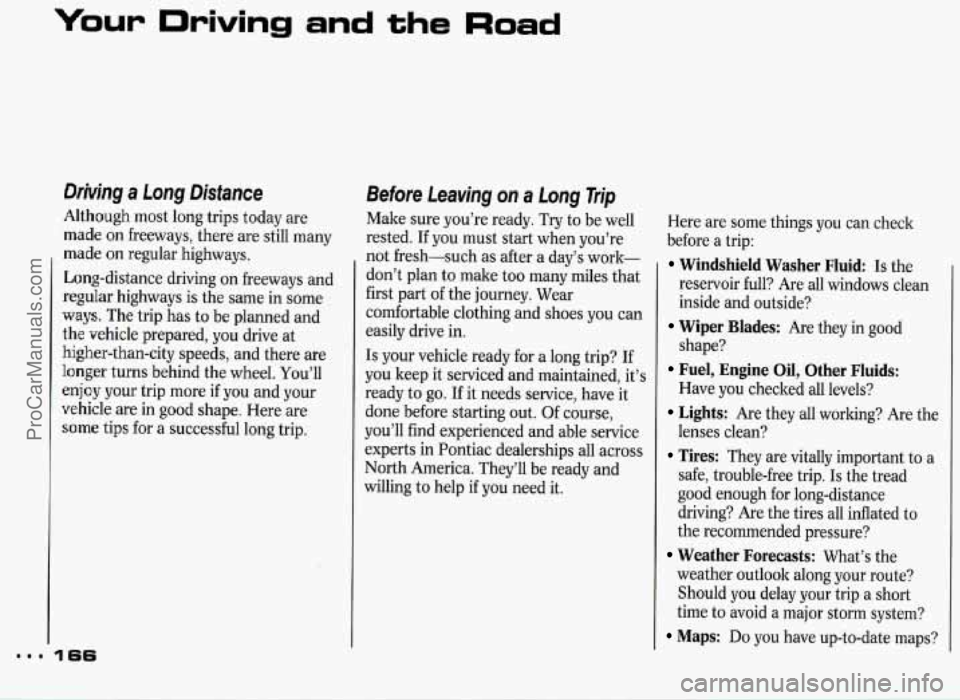Page 7 of 338
How to Use this Manual
Vehicle Symbols (CQNT.)
These symbols are on some of your
controls:
Windshield
WiperlWasher
Windshield Defroster
Rear Window Defogger
Ventilating Fan
Power Window
These symbols are used on warning and
indicator lights:
Engine Coolant - Fd
Temperature .HccF
Battery Charging
System
Fuel
Engine Oil Pressure
Brake
Anti-Lock Brakes
Here are some other symbols you may
see:
Fuse
Trunk Release
Lighter
Horn
Speaker
Hood Release
ProCarManuals.com
Page 57 of 338

If you drive too quickly through I
deep puddles or standing water,
water can come in through your
engine’s air intake and badly
damage your engine. If you can
avoid deep puddles or standin
water, dr&e through them ve
Engine Block Heater (OPTION)
In very cold weather, 0°F (-18°C) or
colder, the engine block heater can
help. You’ll get easier starting and
better fuel economy during engine
warm-up.
To Use the Block Heater:
1. Turn off the engine.
2. Open the hood and unwrap the
3. Plug it into a normal, grounded
electrical cord.
110-volt outlet.
Plugging the cord into an
ungrounded outlet could
cause an electrical shock.
Also, the
wrong kind
of extension cord could
overheat and cause a fire. You
could be seriously injured. Plug the
cord into a properly grounded
three-prong
1 10-volt outlet. If the
cord won’t reach, use a heavy-duty
three-prong extension cord rated
for at least 15 amps.
NOTICE
After you’ve used the block heater,
be sure to store the cord as it was
before, to keep it away from
moving engine parts.
If you dol
it could be damaged. .
.,.~~,~..~~~,~.= -~ -..= ~,,“~~,-~,~~=~~.-~,~-, F,I,,,i ,... ~~
How long should you keep the block
heater plugged in? The answer depends
on the weather, the kind of oil you have,
and some other things. Instead
of trying
to list everything here, we ask that you
contact a Pontiac dealer in the area
where you’ll be parking your vehicle.
The dealer can give you the best advice
for that particular area.
ProCarManuals.com
Page 58 of 338
$;. +..* s.:
P-
::
. PW~Oil ..
. Shi ng the Automatic
Transale
Your automatic transaxle may have a
shift lever located on the steering
column or on the console between the
seats. Both are shown above.
Maximum engine speed
is limited on
automatic transaxle vehicles when
you’re
in D (Drive) or N (Neutral), to
protect driveline components from
improper operation.
h
There are six shift positions, seven if
you have Overdrive. In this manual,
these are referred to by the commonly
used symbols in the right column
below:
Park P
Reverse R
Neutral N
Overdrive (DI
Drive D
Second 2
First 1
Park
P (Park): This locks your front
wheels. It’s the best position to use
when you start your engine because
your vehicle can’t move
easily.
ProCarManuals.com
Page 101 of 338

mmm
Features & Controls
I
Oil Warning Light
If you have a problem with your oil, this
light may stay on after you start
your
engine, or come on when you are
driving. This indicates that oil
is not
going through your engine quickly
enough to
keep it lubricated. The
engine
could be low on oil, or could
have some other oil problem. Have it
fixed right away.
3 00
The oil light could also come on in three
other situations:
When the ignition is but the engine
is not running, the light will come on
as a test to show you it is working,
but the light
will go out when you
turn the ignition to Start. If it doesn’t
come on with the ignition on, you
may have a problem with the fuse or
bulb.
Have it fixed right away.
Sometimes when the engine is idling
at
a stop, the light may blink on and
off. This is normal.
If you make a hard stop, the light may
come on for ‘a moment. This is
normal.
Don’t keep driving if the oil
pressure is low. If you do,
your engine can become so hot that
it catches he. You or others could
be burned. Check your oil as soon
as possible and have yaw vehicle
NOTICE
ProCarManuals.com
Page 102 of 338

Oil Pressure Indicator (OPTION)
This indicator tells you if there could be
a problem with your engine oil pressure.
The pointer should be above the red
zone when the engine is running.
I CAUTION
Readings in the red area tell you that
the engine is low on oil, or that you
might have some other oil problem. See
the
Index under Engine Oil.
Don't keep driving if the oil
pressure is low.
If you do,
your engine can become
so hot that
it catches fire, You or others could
be burned. Check your oil as soon
as possible and have your vehicle
serviced.
Battery Warning Light
The charging system light will come on
briefly when you turn on the ignition
as
a check to show you it is working. Then
it should go out.
If it stays on, or comes
on while you are driving, you may have
a problem with the electrical charging
system. It could indicate that
you have
a loose generator drive belt
or another
electrical problem. Have it checked
right away. Driving while this light
is on
could drain your battery.
If you must drive a short distance with
the light
on, be certain to turn off all
your accessories, such as the radio and
air conditioner.
101
ProCarManuals.com
Page 105 of 338

Features & Controls
Malfunction Incfkator Lamp
(Semite Engine Soon Light)
A computer monitors operation of your
fuel, ignition and emission control
systems. This light should
come on
when the ignition is on, but the engine
is not running, as a check to show you
it is,
working. If it does not come on at
all, have it fixed right away. If it stays
on, or it comes on while you are driving,
the computer is indicating that yo8u
have a problem. You should take your
vehicle in for service soon.
If you keep driving your vehicle
with
this light on, after a while th
emission controls won't work as
well, your fuel economy won't be
as good and your engine may not
run as smoothly. This could lead to
costly repai+p@,cqered
by your warranty :',~: ~;'='-- ~ -'--:< .:-
Check Gauges Light (OPTION)
The CHECK GAUGES light will come
on
if your oil pressure gage or engine
coolant temperature gage
is pointing to
the red area.
If these gages do not indicate a
problem, the CHECK GAUGES light
means there is
a problem with your
vehicle's charging system.
ProCarManuals.com
Page 167 of 338

Your Driving and the Road
Drkjng a Long Distance
Although most long trips today are
made on freeways, there are still many
made
on regular highways.
Long-distance driving on freeways and
reguIar highways is the same in some
ways. The trip has to be planned and
the vehicle prepared, you drive at
higher-than-city speeds, and there are
longer turns behind the wheel. You’ll
enjoy your trip more if you and your
vehicle are in good shape. Here are
some tips for a successful long trip.
Before Leaving on a Long Trip
Make sure you’re ready. Try to be well
rested. If you must start when you’re
not fresh-such as after a day’s work-
don’t plan to make too many miles that
first part of the journey. Wear
comfortable clothing and shoes you can
easily drive in.
Is your vehicle ready for a long trip? If
you keep it serviced and maintained, it’s
ready to go. If it needs service, have it
done before starting out. Of course,
you’ll find experienced and able service
experts in Pontiac dealerships all across
North America. They’ll be ready and
willing to help
if you need it. Here
are some things you can check
before a trip:
Windshield Washer Fluid Is the
reservoir full? Are all windows clean
inside and outside?
shape?
Have you checked all levels?
lenses clean? safe, trouble-free trip.
Is the tread
good enough for long-distance
driving? Are the tires all inflated to
the recommended pressure?
weather outlook along your route?
Should
you delay your trip a short
time to avoid a major storm system?
Maps: Do you have up-to-date maps?
Wiper Blades: Are they in good
Fuel, Engine Oil, Other Fluids:
Lights: Are they all working? Are the
Tires: They are vitally important to a
Weather Forecasts: What’s the
ProCarManuals.com
Page 182 of 338

Parking on Hills
You really should not park your vehicle,
with a trailer attached, on a hill.
If
something goes wrong, your rig could
start to move. People can be injured,
and both your vehicle and the trailer
can be damaged.
But if you ever have to park your rig on
a hill, here’s how to do it:
1. Apply your regular brakes, but don’t
shift into
P (Park) yet.
2. Have someone place chocks under
the trailer wheels.
3. When the wheel chocks are in place,
release the regular brakes until the
chocks absorb the load.
4. Reapply the regular brakes. Then
apply your parking brake, and then
shift to
P (Park).
5. Release the regular brakes.
When You Are Ready to Leave After
Parking
on a Hill
1. Apply your regular brakes and hold
the pedal down while you:
Start your engine;
Shift into a gear; and
Release the parking brake.
2. Let up on the brake pedal.
3. Drive slowly until the trailer is clear
4. Stop and have someone pick up and
of
the chocks.
store the choclts.
Maintenance When Trailer Towing
Your vehicle will need service more
often when you’re pulling a trailer. See
the Maintenance Schedule for more on
this. Things that are especially
important in trailer operation
are
automatic transaxle fluid (don’t
overfill), engine oil, belts, cooling
system, and brake adjustment. Each
of
these is covered in this manual, and the
Index will help you find them quickly. If
you’re trailering, it’s a good idea to
review these sections before you start
your trip.
Check periodically to see that all hitch
nuts and bolts are tight.
IBI ...
ProCarManuals.com